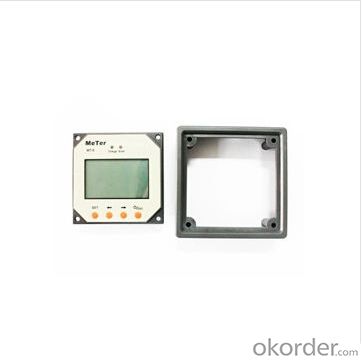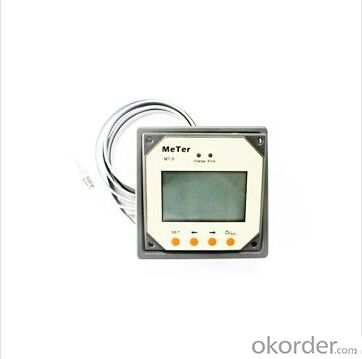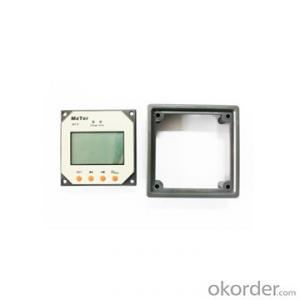Remote Display for EPIPDB-COM Series,Remote Meter MT-1
- Loading Port:
- Tianjin
- Payment Terms:
- TT or LC
- Min Order Qty:
- 60 pc
- Supply Capability:
- 10000 pc/month
OKorder Service Pledge
OKorder Financial Service
You Might Also Like
MT-1 is an optional accessory for EPIPDB-COM series solar charge controller. The LCD displays the system status and parameters clearly.
Features:
·Display the system status and parameters with digital and graphic icon.
·Battery type selectable
·Battery Ah setting function
·Temperature compensation coefficient adjustable
·Four keys to solve the setting easily
·Control the load by manual
Specification:
Rated voltage | 12V, min voltage (suggest): 8.0V |
Strong backlight on | <23mA |
Low backlight on | <20mA |
Backlight and LED indicator off | <17mA |
Operation temperature | -40℃ ~ +60℃ |
LCD operation temperature | -10℃ ~ +40℃ |
Humidity | 0-100% |
Communication cable | RJ45(8PIN), 10 meter |
Battery voltage parameters (temperature at 25°C) | |||
Battery charging setting | Sealed | Flooded | Gel |
Equalize charging voltage | 14.4 V;x2/24V | 14.6V;x2/24V | 14.8V;x2/24V |
Boost charging voltage | 14.2V;x2/24V | 14.4V;x2/24V | 14.6V;x2/24V |
Float charging voltage | 13.7V;x2/24V | 13.7V;x2/24V | 13.7V;x2/24V |
Max. solar voltage | 30V(12V system),55V(24V system) | ||
Battery voltage range | 8-15V(12V system),8-30V(24V system) | ||
Self-consumption | 4mA at night, 10mA at charging | ||
Meterbus connection | 8-pin RJ-45 | ||
Temp. compensation | -5mv/℃/2V | ||


FAQ:
Q1. What is the voltage?
A1. Our 45/60A solar charge controller is 12/24/36/48V auto work.
Q2. What is the difference between MPPT&PWM?
A2. MPPT has higher efficiency, it can track the max power point and won't waste energy.
Q3. What is the efficiency of the MPPT controller?
A3. MPPT>99%, peak conversion efficiency>98%.
Q4. What is the waranty of product?
A4. 12 months.
Q5. What protection does your MPPT controller have?
A5. PV array short circuit, PV reverse polarity, Battery reverse polarity, Over charging, Output short circuit.
- Q:Can a solar controller be used with a portable solar panel?
- Certainly, a portable solar panel can indeed be paired with a solar controller. The primary function of a solar controller is to oversee the charging process of a solar panel and safeguard the battery against overcharging. Serving as an intermediary between the solar panel and the battery, it guarantees the battery's receipt of an optimal charge level. Irrespective of whether the solar panel is portable or stationary, utilizing a solar controller enables the battery to achieve peak efficiency and prolong its lifespan.
- Q:Solar controller 10a, a represents what
- A, represents the current. Indicates the current that is allowed to pass during operation of the controller.
- Q:Can a solar controller be used with solar-powered pool heaters?
- Yes, a solar controller can be used with solar-powered pool heaters. A solar controller is an essential component of a solar heating system, especially for pool heaters. It helps to regulate and optimize the flow of solar energy from the solar panels to the pool water, ensuring efficient heating and preventing overheating. The controller monitors the temperature of the pool water and adjusts the flow of water through the solar panels accordingly. It also controls the circulation pumps and valves to achieve the desired temperature in the pool. Therefore, utilizing a solar controller with solar-powered pool heaters is highly recommended to maximize the effectiveness and efficiency of the solar heating system.
- Q:How do I ensure compliance with local regulations when installing a solar controller?
- To ensure compliance with local regulations when installing a solar controller, it is important to familiarize yourself with the specific regulations in your area. This can be done by researching local codes, permits, and requirements related to solar installations. It is advisable to consult with local authorities or regulatory bodies to ensure that you are meeting all the necessary guidelines. Additionally, hiring a licensed and certified professional for the installation can help ensure compliance with local regulations and standards.
- Q:Can a solar controller be used in a solar-powered water desalination system?
- Yes, a solar controller can be used in a solar-powered water desalination system. The solar controller is responsible for regulating and optimizing the energy flow from the solar panels to the system, ensuring efficient operation and protecting the batteries from overcharging or discharging. In a solar-powered water desalination system, the solar controller would play a crucial role in managing the energy supply to power the desalination process, making it an essential component for effective and sustainable operation.
- Q:What is the maximum discharge current that a solar controller can provide?
- The specific model and capacity of a solar controller determine its maximum discharge current. Solar controllers are designed to regulate the flow of electrical current between the solar panel and the battery or load. They have a maximum discharge current rating, which dictates the maximum current that can be drawn from the battery or load. Manufacturers usually specify the maximum discharge current rating, which can vary significantly depending on the size and capabilities of the solar controller. It is important to choose a compatible solar controller that can meet the anticipated load or battery discharge requirements. Smaller solar controllers may have a maximum discharge current rating of approximately 10-20 amps, whereas larger controllers with high capacity can support discharge currents of 100 amps or more. To determine the maximum discharge current capacity, it is essential to refer to the product specifications or datasheet of the specific solar controller. Exceeding the maximum discharge current rating of a solar controller can result in overheating, reduced efficiency, and potential damage to the controller or connected components. Therefore, it is crucial to ensure that the chosen solar controller can handle the maximum discharge current requirements of the system.
- Q:Can a solar controller be used in a solar-powered interplanetary travel system?
- Yes, a solar controller can be used in a solar-powered interplanetary travel system. A solar controller is responsible for regulating and optimizing the charging and discharging of batteries within a solar power system. In an interplanetary travel system, solar panels would be used to harness the energy of the sun, and a solar controller would be essential to manage the power flow, ensure efficient energy storage, and protect the batteries from overcharging or discharging.
- Q:How do I prevent undercharging of batteries with a solar controller?
- To prevent undercharging of batteries with a solar controller, you can follow a few key steps: 1. Ensure proper battery sizing: Make sure your solar controller is compatible with the battery capacity and voltage you are using. Undersized controllers may not be able to properly charge the batteries. 2. Optimize solar panel capacity: Ensure that your solar panel capacity is sufficient to meet the charging needs of your batteries. If the solar panel capacity is too low, it might not generate enough energy to fully charge the batteries. 3. Set appropriate charging parameters: Adjust the charging parameters on your solar controller according to the battery manufacturer's recommendations. This includes setting the correct charging voltage, absorption time, and float voltage, which will help prevent undercharging. 4. Monitor battery status: Regularly monitor the battery status using a battery monitor or built-in controller features. This will help you identify any potential issues with undercharging and take corrective actions promptly. 5. Implement proper maintenance: Perform regular battery maintenance, including checking for any signs of sulfation or corrosion, and cleaning the battery terminals. A well-maintained battery will be more efficient and less prone to undercharging. By following these steps, you can ensure that your solar controller charges your batteries optimally, preventing undercharging and maximizing their lifespan and performance.
- Q:Can a solar controller be used with solar panel arrays in series?
- Yes, a solar controller can be used with solar panel arrays in series. The solar controller regulates the charging and discharging of the batteries and ensures that the solar panels are operating optimally. Whether the solar panels are connected in series or parallel, the solar controller can still effectively manage the flow of power and protect the batteries from overcharging or overdischarging.
- Q:Can a solar controller be used with solar panels that are mounted on a rooftop?
- Yes, a solar controller can be used with solar panels that are mounted on a rooftop. A solar controller, also known as a charge controller, is a device that regulates the charging of batteries in a solar power system. It is typically installed between the solar panels and the batteries to prevent overcharging and over-discharging of the batteries. Regardless of whether the solar panels are mounted on a rooftop or any other location, a solar controller is an essential component of a solar power system. It helps to optimize the charging process, protect the batteries from damage, and increase the overall efficiency of the system. Rooftop-mounted solar panels are a popular choice for residential and commercial installations due to their ease of installation and available space. In such installations, the solar controller plays a crucial role in ensuring that the batteries are charged properly and that the solar energy is effectively utilized. Therefore, whether the solar panels are mounted on a rooftop or any other location, a solar controller is necessary to regulate the charging process and ensure the longevity and efficiency of the solar power system.
1. Manufacturer Overview |
|
|---|---|
| Location | |
| Year Established | |
| Annual Output Value | |
| Main Markets | |
| Company Certifications | |
2. Manufacturer Certificates |
|
|---|---|
| a) Certification Name | |
| Range | |
| Reference | |
| Validity Period | |
3. Manufacturer Capability |
|
|---|---|
| a)Trade Capacity | |
| Nearest Port | |
| Export Percentage | |
| No.of Employees in Trade Department | |
| Language Spoken: | |
| b)Factory Information | |
| Factory Size: | |
| No. of Production Lines | |
| Contract Manufacturing | |
| Product Price Range | |
Send your message to us
Remote Display for EPIPDB-COM Series,Remote Meter MT-1
- Loading Port:
- Tianjin
- Payment Terms:
- TT or LC
- Min Order Qty:
- 60 pc
- Supply Capability:
- 10000 pc/month
OKorder Service Pledge
OKorder Financial Service
Similar products
New products
Hot products
Related keywords





























